
Hit the Ground Running
You'll remember from the previous post that "correct running form asks only that runners eliminate the variables, and reinforce the invariables." In running, while foot-to-ground contact is a given, does nature favor one manner of landing and loading over another? Let's find out.
Heel Strike
Common to about 75 percent of runners, the heel strike is both maligned and celebrated. What's it all about?

Initial Ground Contact: Heel-Strike Landing -- well ahead of the GCM
A heel-strike landing actively swings the foot well out in front of the runner's general center of mass (GCM), into a braking position. Imagine repeatedly reaching out with a straight leg and a heel edge that collides with the ground to hold off the body weight on... BAM... every... BAM... single... BAM... running... BAM... stride... BAM... BAM... BAM... BAM. Ouch! Right?
Can you say,
- Knee pain,
- Hip pain,
- Back pain?
Yeah, I thought you could.
Yes, the body makes some concessions for heel-first landings by rolling at the ankle and rotating at the hip, but, in spite of Olympian Jeff Galloway's description of its being "cushioning," a heel strike adds a lot of noise to an otherwise elegantly quiet system of support.
You see, a heel strike adds what's seen on a graph as a force spike well ahead of our natural supportive loading. This impact at touchdown sends a tremor of about two times body weight straight into the foot, through the leg, and into the hip and back. You can even hear what Hunter S. Thompson called "a hell broth of slapping and pounding feet" as any group of actively landing runners passes. Check out Dan Leiberman's "Barefoot Running: The Biomechanics of Foot Strike" video clips and realtime force plate graphs and you'll immediately see how this undue loading of the runner's body occurs through the severely active landing of a heel strike.
But, because most runners today are wearing big, bulky shoes, they're not going to feel very much regardless of how they interact with the ground. In fact, many runners don't even know whether or not they heel strike. They've probably never thought about it because they never felt the need. Take off those clunky shoes, though, and run barefooted over a paved surface and any heel strike becomes a concern right away. That's because instead of a thick, wide, and heavily-padded shoe bottom, they are now subjecting their small, hard, naked heel bone -- hardly the body's favored touchdown point -- to an unforgiving ground. They'll quickly put their shoes back on or run start running differently.
Now, since there are some 25 percent of runners who do not "naturally" heel strike (and without shoes there would surely be a whole lot more) it's clear that heel striking is a variable part of a running stride.
Mid-Foot Landing
Since the actual "mid-foot" is a series of bones at the apex of the arch, it cannot actually function as a landing pad, right?
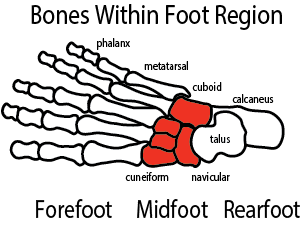
Skeletal Diagram of Foot -- note "Midfoot." Image courtesy of Pose Tech and Dr. Andrey Pyanzin
So, what's really meant by "mid-foot" is a flat-footed landing where both heel and ball of foot touch the ground simultaneously. But this is mostly a visual illusion. Shoes tend to have elevated heels that would favor a forefoot landing... no, a heel-strike... er, a flat-footed landing, but it's hard to tell because it can't really be felt, anyway. It can be measured by pressure-sensitive devices, but typically contact occurs at either the forefoot or the heel. Flat-footed landings are rare.
One characteristic of this active "mid-foot" landing is that it occurs, like the heel strike, well in front of the body's general center of mass (GCM), so again, it's a braking force. While it usually doesn't produce an impact transient that's as abrupt as the heel strike, an unnecessary force is still present.
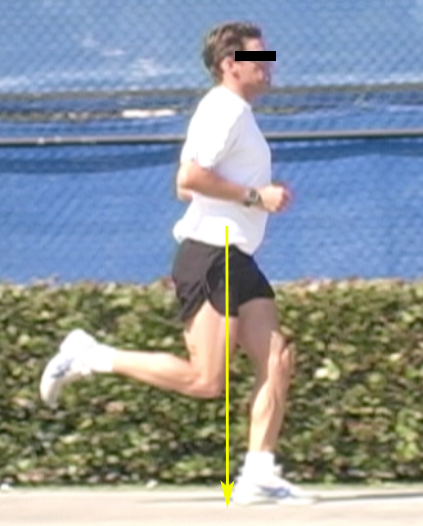
Initial Ground Contact: Mid-foot Landing -- well ahead of GCM
For such an active landing, the penalties may include:
- Sliding inside the shoe -- friction equals blisters, and toes being jammed into the toe-box can result in black toenails.
- Muscles absorbing greater loads, for longer periods, increases fatigue.
- And the delay of falling into the new stride just perpetuates this cycle.
Another negative with a flat-footed landing is that it bypasses, and thus wastes, the metabolically free elastic rebound inherent within the foot, and the coordinated mechanisms of the ball of the foot and the ankle joints. Worse, plenty of people when learning to run barefooted, or with minimal footwear, or even when trying out anything other than a heel-strike landing in whatever shoes, tend to add unnecessary effort. They errantly reach out toward the ground to find their next support. This active landing pits firing muscles -- calves and quadriceps -- and a misaligned skeletal structure against gravity during landing. Injury often follows. Sadly, blame is normally directed at the (lack of) footwear rather than at runners' faulty form.
Again, since some runners do not land on their so-called mid foot, it too is a variable component of running.
Paw Back
The idea that a runner can "paw back at the ground" or otherwise slam their foot into the ground to catapult themselves over that point of contact, and into the next stride is again a visual illusion, a mistaken interpretation of hamstring muscles activity prior to ground contact, and a gross misunderstanding of biomechanical function. For now, because paw back so obviously convolutes any reasonable concept of a natural landing in running we'll leave it as just another affectation that adds damaging impact -- a variable.
The Running Pose
Every runner, no matter how they get into it, reaches the running Pose. Some land in it as they are touching down. The rest progress into it following the aforementioned variables above.
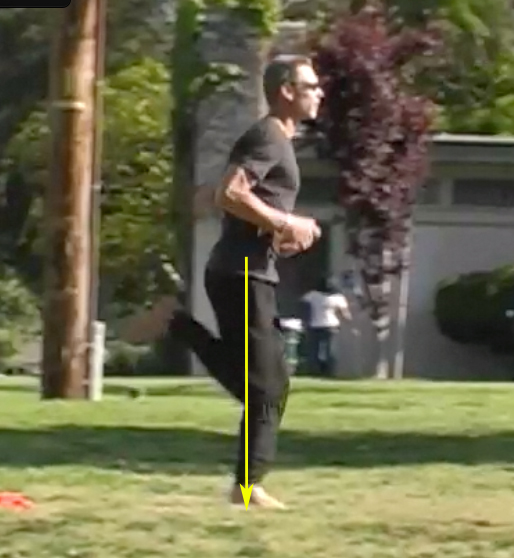
Initial Ground Contact: Landing Close to Pose Position
And, into the Pose Position...
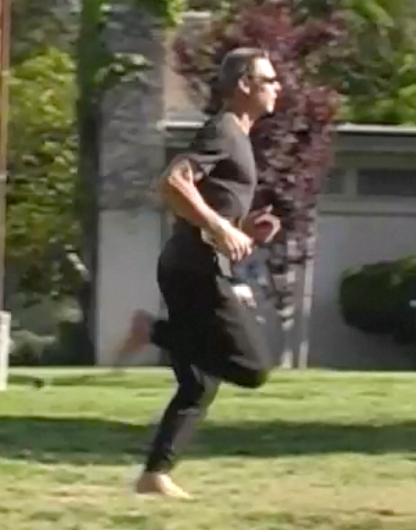
Pose Position
The running Pose is seen as one singular point in space and time that separates the previous stride from the next. Its key visual characteristics are that bodyweight is on the ball of the foot, the ankle and knee joints are bent, and the swing foot is tucked up beneath the hip. The less obvious indicators of the running Pose occur when the runner's general center of mass (GCM), the swing leg's center of mass, and the ball of the foot (BOF) are all aligned. Ideally, this happens right at the "vertical moment," but it's often realized just slightly beyond (as above, and as detailed below). Until you reach this position you're still in the previous stride.
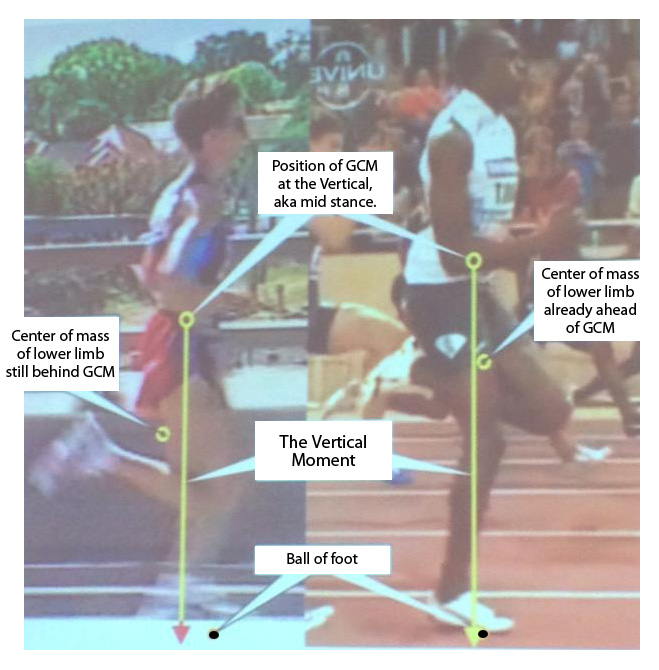
The Vertical Moment
What's important to note is that by landing in the running Pose, the loading curve of ground reaction is smooth and gradual as the lower limb is allowed to exercise its natural biomechanical springiness. The two to three times bodyweight load of ground reaction applied here is exactly the force that modeled our running bodies, and is distinct from impact, the undue shock created by those active landings above. I might point out that the vast majority of running injury stems from landing. Landing in the running Pose eliminates one of the prime causes of injury.
From the running Pose -- the first invariable -- emerges a standard from which to distinguish incorrect and correct running form.
So it's here, from this Pose position, the runner stands on the precipice, ready to give himself to gravity, and begin falling forward at 9.8m/sec./sec. into the next stride. The goal then, and what defines correct running form, is to get into and out of the Pose position -- onto and off of support -- "on time." We'll get to that in a bit.
Now, we move forward with Free Falling ("Running Form: Simplified -- Part 3").
For more by Christopher Drozd, click here.
For more on fitness and exercise, click here.